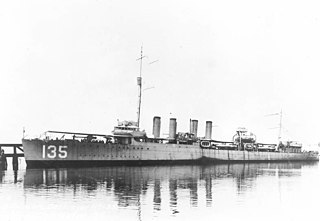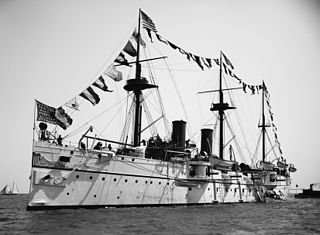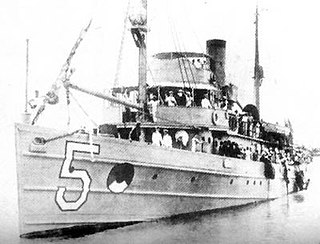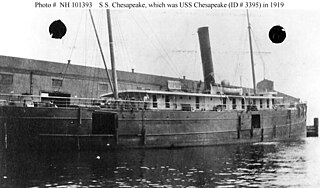
The fourth USS Baltimore (C-3) was a United States Navy cruiser, the fifth protected cruiser to be built by an American yard. Like the previous one, Charleston, the design was commissioned from the British company of W. Armstrong, Mitchell, and Company of Newcastle. Baltimore was an all-around improvement on Charleston, somewhat larger with more guns, thicker armor, and better machinery.

Minelaying is the act of deploying explosive mines. Historically this has been carried out by ships, submarines and aircraft. Additionally, since World War I the term minelayer refers specifically to a naval ship used for deploying naval mines. "Mine planting" was the term for installing controlled mines at predetermined positions in connection with coastal fortifications or harbor approaches that would be detonated by shore control when a ship was fixed as being within the mine's effective range.

The first USS Tillman (DD–135) was a Wickes-class destroyer in the United States Navy. She was named for Senator Benjamin Tillman. Transferred to the United Kingdom in World War II, she was commissioned in the Royal Navy as HMS Wells.

USS Oglala (ID-1255/CM-4/ARG-1) was a minelayer in the United States Navy. Commissioned as Massachusetts, she was renamed Shawmut a month later, and in 1928, was renamed after the Oglala, a sub-tribe of the Lakota, residing in the Black Hills of South Dakota.

The first USS San Francisco (C-5) was a steel protected cruiser in the United States Navy. She was later named Tahoe and then Yosemite, becoming the third US Navy ship to bear the name Yosemite. She generally resembled her predecessor Newark, with a main armament of twelve 6-inch guns.

The North Sea Mine Barrage, also known as the Northern Barrage, was a large minefield laid easterly from the Orkney Islands to Norway by the United States Navy during World War I. The objective was to inhibit the movement of U-boats from bases in Germany to the Atlantic shipping lanes bringing supplies to the British Isles. Rear Admiral Lewis Clinton-Baker, commanding the Royal Navy minelaying force at the time, described the barrage as the "biggest mine planting stunt in the world's history." Larger fields with greater numbers of mines were laid during World War II.

USS Aroostook (ID-1256/CM-3/AK-44) was the Eastern Steamship Company's Bunker Hill converted for planting the World War I North Sea Mine Barrage. Bunker Hill was built in 1907 at Philadelphia, Pennsylvania for passenger service between Boston and New York City. Bunker Hill was one of three sister ships, the others being Massachusetts and Old Colony, delivered as passenger/cargo ships by William Cramp & Sons in 1907. They were among the eight ships acquired by the U.S. Navy in November 1917. Bunker Hill and Massachusetts were converted to minelayers at the Boston Navy Yard. Old Colony was used as a district scout until sent across the Atlantic and turned over to the British in 1919.

USS Tanager (AM-5) was an Lapwing-class minesweeper acquired by the U.S. Navy for the dangerous task of removing mines from minefields laid in the water to prevent ships from passing.

USS Auk (AM-38) was a Lapwing-class minesweeper acquired by the U.S. Navy after World War I for the task of removing mines that had been placed during the war.

The second USS Canonicus was the Southern Pacific freighter El Cid temporarily converted for planting the World War I North Sea Mine Barrage. Newport News Shipbuilding and Dry Dock Company launched El Cid at Newport News, Virginia on 7 October 1899 for service between New York City and Gulf of Mexico seaports of New Orleans and Galveston, Texas. The United States Shipping Board took control of the ship from Southern Pacific Steamship Company in 1917.

The third USS Chesapeake (ID-3395) was a United States Navy salvage ship in commission from March to October 1919.

SS Yorktown was launched February 10, 1894, by Delaware River Iron Ship Building and Engine Works, Chester, Pennsylvania for the Old Dominion Steamship Company for the company's overnight New York City/Norfolk, Virginia service. The United States Navy purchased Yorktown on April 21, 1898, to be commissioned as the second USS Resolute, an auxiliary cruiser and transport that saw naval service during the Spanish–American War 1898–1899. The United States Department of War acquired the ship on January 22, 1900, for service as the United States Army Transport (USAT) Rawlings. The ship was sold to the Merchants and Miners Transportation Company of Baltimore, Maryland on July 27, 1901, and renamed Powhatan. Powhatan was wrecked in 1916 and in 1919 rebuilt as the world's first turbo-electric propelled passenger ship Cuba for luxury passenger and express freight service between Florida and Cuba with the Miami Steamship Company beginning service in 1920. Renamed Seneca, the ship burned and sank December 30, 1927, at Hoboken, New Jersey then refloated September 2, 1928, and scrapped.
USS Ozama was a naval mine carrier that served in the United States Navy from 1917 to 1919.

The second USS Kiowa (ID-1842) was a cargo ship that served in the United States Navy from 1918 to 1919.

United States Navy operations during World War I began on April 6, 1917, after the formal declaration of war on the German Empire. The American navy focused on countering enemy U-boats in the Atlantic Ocean and the Mediterranean Sea, while convoying men and supplies to France and Italy. Because of United States' late entry into the war, her capital ships never engaged the German fleet, and few decisive submarine actions occurred.

The second USS Housatonic was the Southern Pacific Steamship Company freighter El Rio. The ship was one of four company ships temporarily converted for planting the World War I North Sea Mine Barrage.
The third USS Roanoke was the Southern Pacific freighter El Dia temporarily converted for planting the World War I North Sea Mine Barrage. Newport News Shipbuilding and Dry Dock Company launched El Dia at Newport News, Virginia on 30 August 1911 for service between New York City and Gulf of Mexico seaports of New Orleans and Galveston, Texas. The United States Shipping Board took control of the ship from Southern Pacific Steamship Company in 1917.
The second USS Canandaigua was the Southern Pacific freighter El Siglo temporarily converted for planting the World War I North Sea Mine Barrage. Newport News Shipbuilding and Dry Dock Company launched El Siglo at Newport News, Virginia in May 1901 for service between New York City and Gulf of Mexico seaports of New Orleans and Galveston, Texas. The United States Shipping Board took control of the ship from Southern Pacific Steamship Company in 1917.

The third USS Quinnebaug was originally the Old Dominion Steamship Company Jefferson built by the Delaware River Iron Ship Building and Engine Works, Chester, Pennsylvania. She was launched on 14 October 1898 and completed during June, 1899. The ship was acquired for World War I naval service and, as USS Quinnebaug, participated in planting the North Sea Mine Barrage. In March 1919 the ship returned to service as Jefferson with the Old Dominion Line.

Rear Admiral Reginald Rowan Belknap was an officer in the United States Navy. He served in the Spanish–American War, Boxer Rebellion, Philippine–American War, and World War I. He gained distinction in 1909 for his relief work in Italy after the 1908 Messina earthquake and tsunami and for his work in command of the first offensive mining campaign in U.S. Navy history, the laying of the North Sea Mine Barrage in 1918. He was also a published author, an inventor, a member of many professional and social organizations, and an active member of the Episcopal Church, and he played a role in the selection of Amelia Earhart as the first female pilot to make a solo flight across the Atlantic Ocean.


















